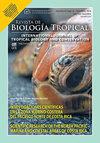Minimalist revision of Mesochorus Gravenhorst, 1829 (Hymenoptera: Ichneumonidae: Mesochorinae) from Área de Conservación Guanacaste, Costa Rica, with 158 new species and host records for 129 species
IF 0.6
4区 生物学
Q4 BIOLOGY
引用次数: 0
Abstract
Introduction: Species of Mesochorus are found worldwide and members of this genus are primarily hyperparasitoids of Ichneumonoidea and Tachinidae. Objectives: To describe species of Costa Rican Mesochorus reared from caterpillars and to a lesser extent Malaise-trapped. Methods: The species are diagnosed by COI mtDNA barcodes, morphological inspection, and host data. A suite of images and host data (plant, caterpillar, and primary parasitoid) are provided for each species. Results: A total of 158 new species of Mesochorus. Sharkey is the taxonomic authority for all. Conclusions: This demonstrates a practical application of DNA barcoding that can be applied to the masses of undescribed neotropical insect species in hyperdiverse groups.对哥斯达黎加瓜纳卡斯特保护区的 Mesochorus Gravenhorst, 1829(膜翅目:Ichneumonidae: Mesochorinae)进行简约修订,包括 158 个新种和 129 个种的寄主记录
简介:Mesochorus属分布于世界各地,主要为姬蚊科和速蚊科的超寄生物。& # x0D;目的:描述哥斯达黎加中音合唱的种类,这些中音合唱是由毛虫饲养的,在较小程度上是由马拉斯诱捕的。& # x0D;方法:采用COI mtDNA条形码、形态检查和宿主资料诊断。为每个物种提供了一套图像和宿主数据(植物、毛虫和初级寄生蜂)。
结果:共发现中曲属158新种。夏基是所有人的分类学权威。& # x0D;结论:这证明了DNA条形码的实际应用,可以应用于大量未描述的新热带昆虫物种的高多样性群体。
本文章由计算机程序翻译,如有差异,请以英文原文为准。
求助全文
约1分钟内获得全文
求助全文
来源期刊

Revista De Biologia Tropical
生物-生物学
CiteScore
1.80
自引率
0.00%
发文量
23
审稿时长
4-8 weeks
期刊介绍:
The Revista de Biología Tropical / International Journal of Tropical Biology and Conservation is a mainstream scientific journal published since 1953 and covered by Web of Science; Science Citation Index; Current Contents; Google Scholar; Scopus, SciELO and nearly 50 additional indices.
A double blind system guarantees you a fair evaluation, and our world class editorial and scientific boards provides a first decision in three working days. The journal is Full Open Access and is widely read where your article can have the highest real impact.
Since its beginning in 1953, the Revista follows these principles: objective and independent evaluation of all manuscripts; transparency in all processes; ethical use of procedures, data, specimens and subjects; fair treatment of all parties; and absolute predominance of scientific rigor over any other aspect.
 求助内容:
求助内容: 应助结果提醒方式:
应助结果提醒方式:


